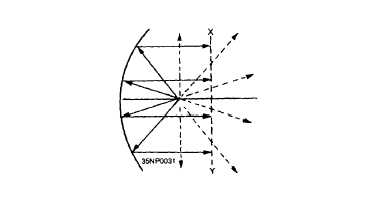Some distribution systems will be more complex.
That is, four antennas can be patched to four receivers,
or one antenna can be patched to more than one
receiver via the multicouplers.
RECEIVING MULTICOUPLER
AN/SRA-12
The AN/SRA-12 filter assembly multicoupler
provides seven radio frequency channels in the 14-kHz
to 32-MHz frequency range. Any of these channels
may be used independently of the other channels, or
they may operate simultaneously. Connections to the
receiver are made by coaxial patch cords, which are
short lengths of cable with a plug attached to each
end.
ANTENNA COUPLER GROUPS
AN/SRA-38, AN/SRA-39, AN/SRA-40,
AN/SRA-49, AN/SRA-49A, and AN/SRA-50
These groups are designed to connect up to 20
mf and hf receivers to a single antenna, with a highly
selective degree of frequency isolation. Each of the
six coupler groups consists of 14 to 20 individual
antenna couplers and a single-power supply module,
all are slide-mounted in a special electronic equipment
rack. An antenna input distribution line termination
(dummy load) is also supplied. In addition, there are
provisions for patching the outputs from the various
antenna couplers to external receivers.
RADAR ANTENNAS
Radar antennas are usually directional antennas
that radiate energy in one lobe or beam. The two most
important characteristics of directional antennas are
directivity and power gain. Most radar systems use
parabolic antennas.
These antennas use parabolic
reflectors in different variations to focus the radiated
energy into a desired beam pattern.
While most radar antennas are parabolic, other
types such as the corner reflector, the broadside array,
and horn radiators may also be used.
PARABOLIC REFLECTORS
To understand why parabolic reflectors are used
for most radar antennas, you need to understand how
radio waves behave. A point source, such as an
omnidirectional antenna produces a spherical radiation
pattern, or spherical wavefront. As the sphere expands,
the energy contained in a given surface area decreases
rapidly. At a relatively short distance from the
antenna, the energy level is so small that its reflection
from a target would be useless in a radar system.
A solution to this problem is to form the energy
into a PLANE wavefront, In a plane wavefront, all
of the energy travels in the same direction, thus
providing more energy to reflect off of a target. To
concentrate the energy even further, a parabolic
reflector is used to shape the plane wavefront’s energy
into a beam of energy. This concentration of energy
provides a maximum amount of energy to be reflected
off of a target, making detection of the target much
more probable.
How does the parabolic reflector focus the radio
waves? Radio waves behave much as light waves do.
Microwaves travel in straight lines as do light rays.
They may be focused or reflected, just as light rays
may be. In figure 2-39, a point-radiation source is
placed at the focal point F. The field leaves this
antema with a spherical wavefront. As each part of
the wavefront moving toward the reflector reaches
the reflecting surface, it is shifted 180 degrees in phase
and sent outward at angles that cause all parts of the
field to travel in parallel paths. Because of the shape
of a parabolic surface, all paths from F to the reflector
and back to line XY are the same length. Therefore,
all parts of the field arrive at line XY at the same time
after reflection.
Figure 2-39.—Parabolic reflector radiation.
Energy that is not directed toward the paraboloid
(dotted lines in fig. 2-39) has a wide-beam characteris-
2-23


